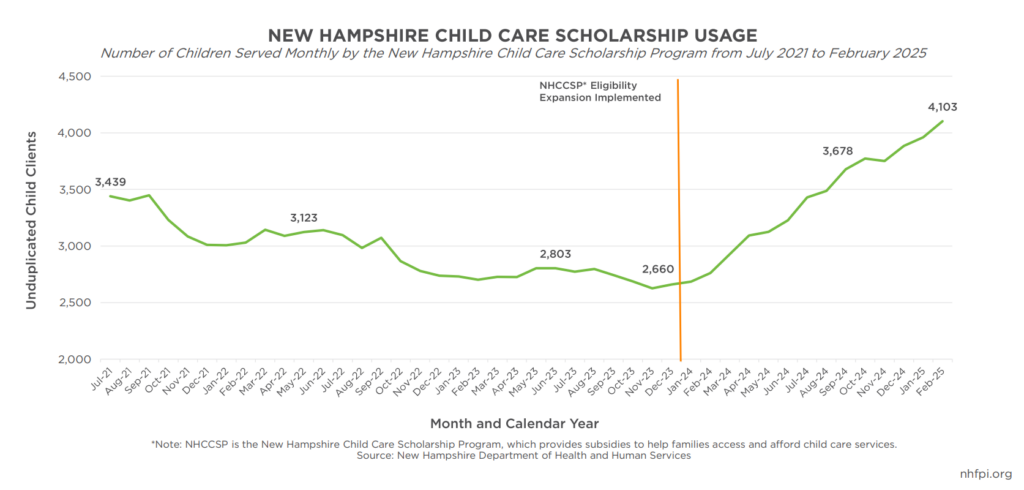New Hampshire’s early childhood care and education (ECE) system is at a critical turning point. Over the past two weeks, I’ve shared new data and key insights about New Hampshire’s ECE system at events hosted by the Endowment for Health, the Department of Health and Human Services, and New Futures —bringing attention to both the demand for child care and the significant economic consequences of unmet needs.
At the center of these conversations is the New Hampshire Child Care Scholarship Program (NHCCSP), a state-federal partnership that provides child care assistance to families with low and moderate incomes, as well as economic impacts of our state ECE shortage.
As eligibility for NHCCSP has expanded, usage has surged—but major gaps remain. Tens of thousands of eligible children are not enrolled, funding levels are far from meeting demand, and the shortage of available child care options is costing families, businesses, and the state economy millions each year.
Here are five essential takeaways from those presentations—underscoring why this issue is so important for Granite Staters.
Since NHCCSP Eligibility Expansion, Usage Increased by 54 Percent
As of February 2025, there were 4,103 children using child care scholarships, the highest rate of usage since approximately State Fiscal Year (SFY) 2020, and a 54.2 percent increase (1,443 children) since December 2023, the month before the eligibility expansion was implemented.
Approximately 55,000 Granite State Children Are Eligible for New Hampshire’s Child Care Scholarship Program, but Only 7-8 Percent are Enrolled
According to data from the Carsey School of Public Policy, approximately 55,000 Granite State children are eligible for NHCCSP under the eligibility expansion. Of those eligible, however, only an estimated 7 to 8 percent were enrolled in the program as of 2024.
$522.6 Million Would Have Been Needed to Enroll all Eligible Granite State Children in NHCCSP
If all eligible children in 2024 were utilizing funds from NHCCSP at the 2024 average cost per child enrolled in NHCCSP ($9,502), the annual cost for the program would have been over $522.6 million. Though a large sum, there is an opportunity for considerable return on investments for ECE funding, particularly with regard to the New Hampshire labor force.
From August 2023 through August 2024, an estimated average of 13 percent of employed Granite State parents left a job, 7 percent lost a job, 12 percent did not look for a job, and 47 percent reduced their working hours to care for their children. Without affordable, reliable, high-quality child care made available through NHCCSP for families with low and moderate incomes, some Granite State residents with children may struggle to join, or fully engage, in the labor force.
New Hampshire House of Representatives Approved Budget Designates Approximately 0.6 Percent of Total Budget to NHCCSP
The House’s version of the SFYs 2026-2027 budget allocates nearly $90.0 million to the budget accounting unit that encompasses NHCCSP funding. This allocation equates to approximately 0.6 percent of the House’s proposed $15.5 billion State Budget for SFYs 2026-2027.
Using the DHHS Division of Economic Stability’s projected average cost per child in the NHCCSP for SFYs 2026-2027 ($8,874), the proposed allocation would allow approximately 5,054 children to utilize NHCCSP funding in SFY 2026 before a waitlist may need to be enacted due to insufficient funds. A waitlist would result in NHCCSP-eligible families being unable to access child care subsidy assistance until additional state or federal funds became available or other families discontinued use of the program.
Additional funding sources may be available to accommodate increased child enrollment in NHCCSP. Federal rules and regulations allow up to 30 percent of Temporary Assistance to Needy Families (TANF) reserve funding to be utilized to address potential funding shortages. Language in the House’s version of the State Budget Trailer Bill also authorizes the DHHS commissioner to request additional funding for the program with approval from the Joint Legislative Fiscal Committee and Governor and Council should a waitlist develop.
Shortage of ECE Slots May Cost New Hampshire $35,000 per Slot in Economic Losses
Every unavailable child care slot may cost the state’s economy as much as $35,000 in lost earnings to families with children under 5 as well as in forgone revenues to businesses and both State and local governments. Specifically, families may have collectively lost as much as $177.9 million dollars in wages in 2023 due to reduced working hours or leaving the workforce, and businesses may have collectively lost as much as $55.5 million due to reduced employee productivity and impacts from benefits paid when employees were not working. Finally, the State and local governments may have lost between $9 million to $14.1 million in potential tax revenue that year, or the equivalent of approximately $1,300 to $2,000 per unavailable child care slot.
To stay up to date on all our ECE-related research, make sure to subscribe to our weekly newsletter, The Bottom Line, at http://nhfpi.org/subscribe.


